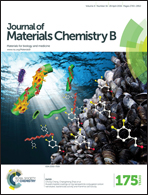Design of cytocompatible bacteria-repellent bio-based polyester films via an aqueous photoactivated process†
Abstract
Nosocomial infections are often induced by the presence of pathogenic organisms on the surface of medical devices or hospital equipment. Chemical or topographical modifications of the surface are recognized as efficient strategies to prevent bacteria adhesion but they may have negative impact on the material interaction with living tissues. Here we have developed a photoactivated method for the modification of a biocompatible polymer, poly(3-hydroxybutyrate-co-3-hydroxyvalerate) (PHBHV) under aqueous conditions. A photoinduced free-radical technique employing a grafting-from process in water media has been successfully performed to covalently anchored fluorine or PEG groups onto PHBHV surfaces. PEGylated hydrophilic surfaces showed higher bacteria-repellency performances than fluorinated hydrophobic films, achieving a >98% anti-adhesion efficiency against Escherichia coli and Staphylococcus aureus. In addition, these surfaces allowed for the adhesion and proliferation of human dermal fibroblasts without the evidence of cytotoxicity.


 Please wait while we load your content...
Please wait while we load your content...